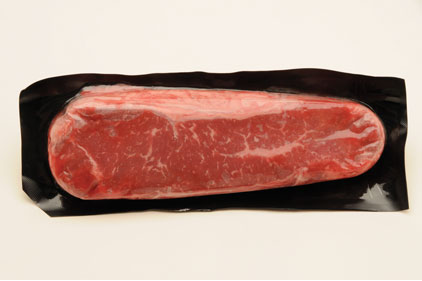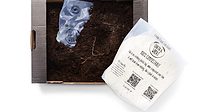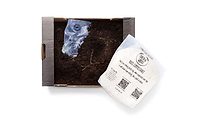
|
| By impregnating one side of the film with sodium nitrite, Curwood scientists were able to give beef wrapped in vacuum packaging the bright red color shoppers expect. Source: DuPont. |
A smidge of sodium nitrite on the food-contact surface of barrier film means the difference between red meat and purple haze, scientists at Curwood Inc. discovered, and the result is a vacuum package that significantly extends the display-case time of beef compared to MAP master packs.
Oshkosh, WI-based Curwood calls its new vacuum package FreshCase, an advancement years in the making, according to Bill Goerich, marketing manager for the new line. While sodium nitrite has a long track record of use in hot dogs, bacon and other meats, adding it to film meant an FDA review to attain GRAS (generally regarded as safe) status. As it slowly rolls out at retailers such as HEB and Walmart for tenderloins, rib eyes and other muscle cuts, FreshCase is gathering innovation laurels. DuPont recently named FreshCase its Diamond award winner as the most innovative new package based on sustainability and reductions in cost and waste.
Whether beef is store wrapped or arrives from a packing house in a low- or high-oxygen master pack, retailers have only a few days to sell the packages before oxidation runs its course and the meat turns brown, forcing stores to mark down the packages for quick sale. Until now, vacuum packs were not an option because, in the absence of any oxygen, the beef retains a purple hue beef eaters find unappealing. With FreshCase, “you can probably display the beef for three weeks before you have to freeze it” to prevent browning, Goerich says.
Sodium nitrite is a common food additive, inhibiting lipid oxidation and some microbial growth, notably botulinum, though it is not effective against pathogens of concern in fresh beef. Curwood’s process involves extruding sodium nitrite on a film’s food-contact layer. After the package is vacuum sealed, enzymatic reactions with the compound result in the formation of nitric oxide, which combines with the meat’s myoglobin to lock in a red appearance. “There are no detectable levels of sodium nitrite in the meat,” adds Goerich.
The DuPont judges gave their highest award to FreshCase partly because of the supply chain efficiencies it provides. Less corrugated material is needed than with case-ready packages in expanded polystyrene trays and PVC overwrap, and more meat can be loaded on a trailer. Goerich maintains the gases in modified atmosphere packages lower a trailer’s capacity by 20,000 lbs. Extended shelf life and fewer leakers also mean reduced food waste.
The film runs on conventional vacuum-packaging machines at the same temperature and machinability as conventional vacuum bags, he says, and is available in an all-clear format or with a black back panel.
Other food packaging recognized by DuPont included flat-bread pouches from Pepperidge Farm and Kraft’s Smart Bottle Inc.’s one-gallon flexible pouch used for salad dressing in foodservice (“Kraft says ‘yes’ to flex,” Food Engineering, March 2012). Pepperidge Farm, working with CP Flexible Packaging and other vendors, eliminated two-thirds of package material for Deli Flats thin rolls by removing the tray, which also shrank the overall package by a quarter, thereby reducing transportation costs.
“The new package format is flow-wrapped on horizontal form/fill/seal equipment and is a much tighter fit,” according to Glen Dupuis of Pepperidge’s packaging R&D department in Norwalk, CT. The packs can be displayed flat or shoulder stacked upright.
For more information:
Bill Goerich, Curwood Inc., 920-527-7772



